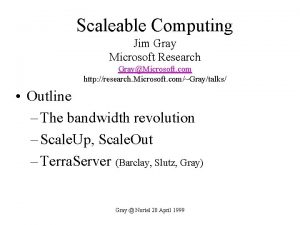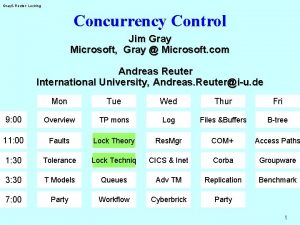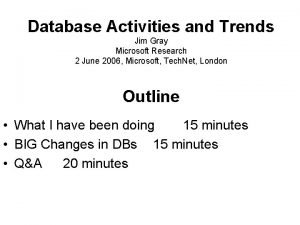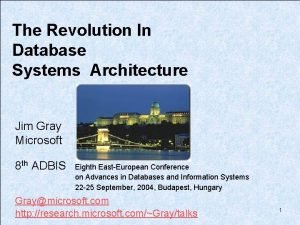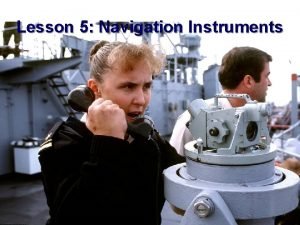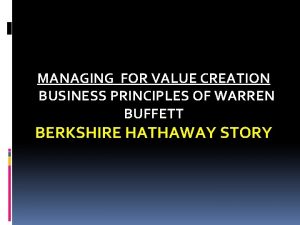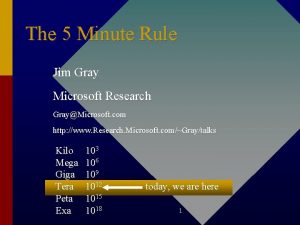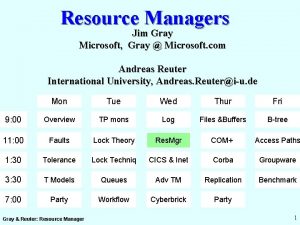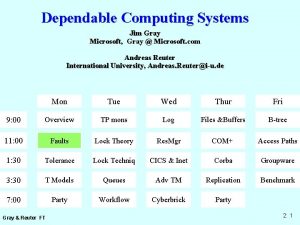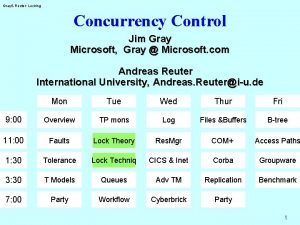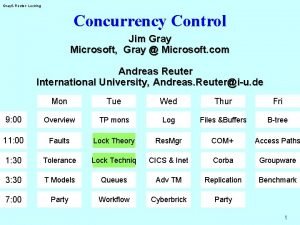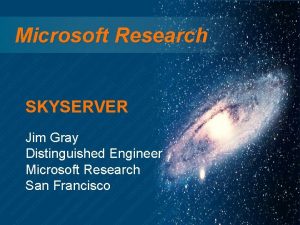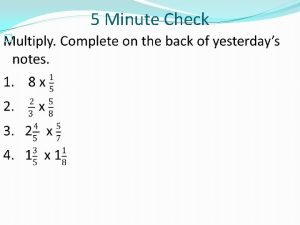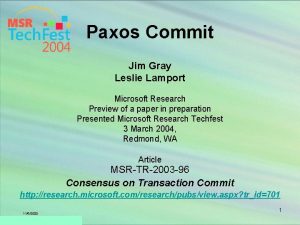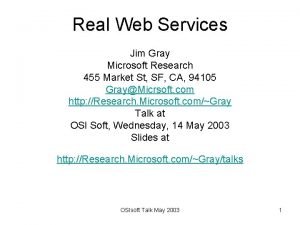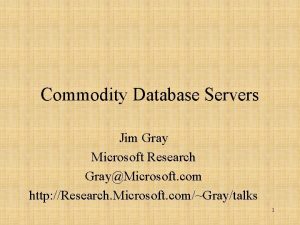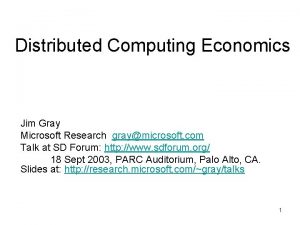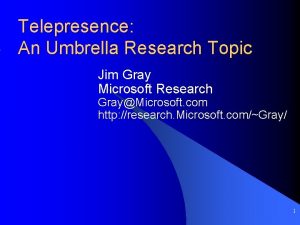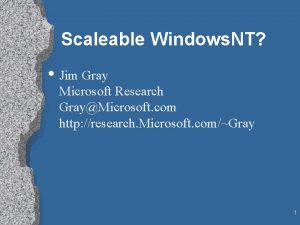The 5 Minute Rule Jim Gray Microsoft Research




















- Slides: 20

The 5 Minute Rule Jim Gray Microsoft Research Gray@Microsoft. com http: //www. Research. Microsoft. com/~Gray/talks Kilo Mega Giga Tera Peta Exa 103 106 109 1012 1015 1018 today, we are here 1

Storage Hierarchy (9 levels) • Cache 1, 2 • Main (1, 2, 3 if n. UMA). • Disk (1 (cached), 2) • Tape (1 (mounted), 2) 2

Meta-Message: Technology Ratios Are Important • If everything gets faster & cheaper at the same rate THEN nothing really changes. • Things getting MUCH BETTER: – – – communication speed & cost 1, 000 x processor speed & cost 100 x storage size & cost 100 x • Things staying about the same – speed of light (more or less constant) – people (10 x more expensive) – storage speed (only 10 x better) 3

Today’s Storage Hierarchy : Speed & Capacity vs Cost Tradeoffs Size vs Speed 1012 109 106 103 104 Cache Nearline Tape Offline Main 102 Tape Disc Secondary Online Secondary Tape 0 Tape 10 Disc Main Offline Nearline Tape -2 $/MB Typical System (bytes) 1015 Price vs Speed 10 Cache 10 -9 10 -6 10 -3 10 0 10 3 Access Time (seconds) 10 -4 10 -9 10 -6 10 -3 10 0 10 3 Access Time (seconds) 4

Storage Ratios Changed • 10 x better access time • 10 x more bandwidth • 4, 000 x lower media price • DRAM/DISK 100: 1 to 10: 10 to 50: 1 5

Thesis: Performance =Storage Accesses not Instructions Executed • In the “old days” we counted instructions and IO’s • Now we count memory references • Processors wait most of the time 6

The Pico Processor 1 M SPECmarks 106 clocks/ fault to bulk ram Event-horizon on chip. VM reincarnated Multi-program cache Terror Bytes! 7

Storage Latency: How Far Away is the Data? 10 9 Andromeda Tape /Optical Robot 10 6 Disk 100 10 2 1 Memory On Board Cache On Chip Cache Registers 2, 000 Years Pluto Sacramento 2 Years 1. 5 hr This Campus 10 min This Room My Head 1 min 8

The Five Minute Rule • Trade DRAM for Disk Accesses • Cost of an access (Drive. Cost / Access_per_second) • Cost of a DRAM page ( $/MB / pages_per_MB) • Break even has two terms: • Technology term and an Economic term • Grew page size to compensate for changing ratios. • Still at 5 minute for random, 1 minute sequential 9

Shows Best Page Index Page Size ~16 KB 10

Standard Storage Metrics • Capacity: – RAM: MB and $/MB: today at 10 MB & 100$/MB – Disk: GB and $/GB: today at 10 GB and 200$/GB – Tape: TB and $/TB: today at. 1 TB and 25 k$/TB (nearline) • Access time (latency) – – – RAM: 100 ns Disk: 10 ms Tape: 30 second pick, 30 second position • Transfer rate – RAM: – Disk: – Tape: 1 GB/s 5 MB/s - - - Arrays can go to 1 GB/s 5 MB/s - - - striping is problematic 11

New Storage Metrics: Kaps, Maps, SCAN? • Kaps: How many kilobyte objects served per second – The file server, transaction processing metric – This is the OLD metric. • Maps: How many megabyte objects served per second – The Multi-Media metric • SCAN: How long to scan all the data – the data mining and utility metric • And – Kaps/$, Maps/$, TBscan/$ 12

For the Record (good 1998 devices packaged in system ) http: //www. tpc. org/results/individual_results/Dell/dell. 6100. 9801. es. pdf X 14 13

How To Get Lots of Maps, SCANs • parallelism: use many little devices in parallel At 10 MB/s: 1. 2 days to scan 1, 000 x parallel: 100 seconds SCAN. Parallelism: divide a big problem into many smaller ones to be solved in parallel. • Beware of the media myth • Beware of the access time myth 14

The Disk Farm On a Card The 100 GB disc card An array of discs Can be used as 100 discs 1 striped disc 10 Fault Tolerant discs. . etc LOTS of accesses/second bandwidth 14" Life is cheap, its the accessories that cost ya. Processors are cheap, it’s the peripherals that cost ya (a 10 k$ disc card). 15

Tape Farms for Tertiary Storage Not Mainframe Silos 100 robots 1 M$ 50 TB 50$/GB 3 K Maps 10 K$ robot 14 tapes 27 hr Scan 500 GB 5 MB/s 20$/GB Scan in 27 hours. independent tape robots 30 Maps many (like a disc farm) 16

The Metrics: Disk and Tape Farms Win GB/K$ 1, 000 Kaps 100, 000 Maps Data Motel: Data checks in, but it never checks ou SCANS/Day 10, 000 100 10 1 0. 01 1000 x Disc Farm STC Tape Robot 6, 000 tapes, 8 readers 100 x DLT Tape Farm 17

Tape & Optical: Beware of the Media Myth Optical is cheap: 200 $/platter 2 GB/platter => 100$/GB (2 x cheaper than disc) Tape is cheap: => 1. 5 $/GB 30 $/tape 20 GB/tape (100 x cheaper than disc). 18

Tape & Optical Reality: Media is 10% of System Cost Tape needs a robot (10 k$. . . 3 m$ ) 10. . . 1000 tapes (at 20 GB each) => 20$/GB. . . 200$/GB (1 x… 10 x cheaper than disc) Optical needs a robot (100 k$ ) 100 platters = 200 GB ( TODAY ) => 400 $/GB ( more expensive than mag disc ) Robots have poor access times Not good for Library of Congress (25 TB) Data motel: data checks in but it never checks out! 19

The Access Time Myth The Myth: seek or pick time dominates The reality: (1) Queuing dominates (2) Transfer dominates BLOBs (3) Disk seeks often short Implication: many cheap servers better than one fast expensive server – shorter queues – parallel transfer – lower cost/access and cost/byte This is now obvious for disk arrays This will be obvious for tape arrays 20
 What happened to terraserver
What happened to terraserver Jim gray microsoft
Jim gray microsoft Jim gray microsoft
Jim gray microsoft Jim gray database
Jim gray database 60 minutes is an hour
60 minutes is an hour 3 minute rule navigation
3 minute rule navigation Microsoft official academic course microsoft word 2016
Microsoft official academic course microsoft word 2016 Microsoft official academic course microsoft excel 2016
Microsoft official academic course microsoft excel 2016 Microsoft microsoft edge startwarren theverge
Microsoft microsoft edge startwarren theverge Microsoft excel merupakan program aplikasi..
Microsoft excel merupakan program aplikasi.. Microsoft official academic course microsoft word 2016
Microsoft official academic course microsoft word 2016 Hình ảnh bộ gõ cơ thể búng tay
Hình ảnh bộ gõ cơ thể búng tay Lp html
Lp html Bổ thể
Bổ thể Tỉ lệ cơ thể trẻ em
Tỉ lệ cơ thể trẻ em Chó sói
Chó sói Thang điểm glasgow
Thang điểm glasgow Chúa sống lại
Chúa sống lại Môn thể thao bắt đầu bằng từ đua
Môn thể thao bắt đầu bằng từ đua Thế nào là hệ số cao nhất
Thế nào là hệ số cao nhất Các châu lục và đại dương trên thế giới
Các châu lục và đại dương trên thế giới
